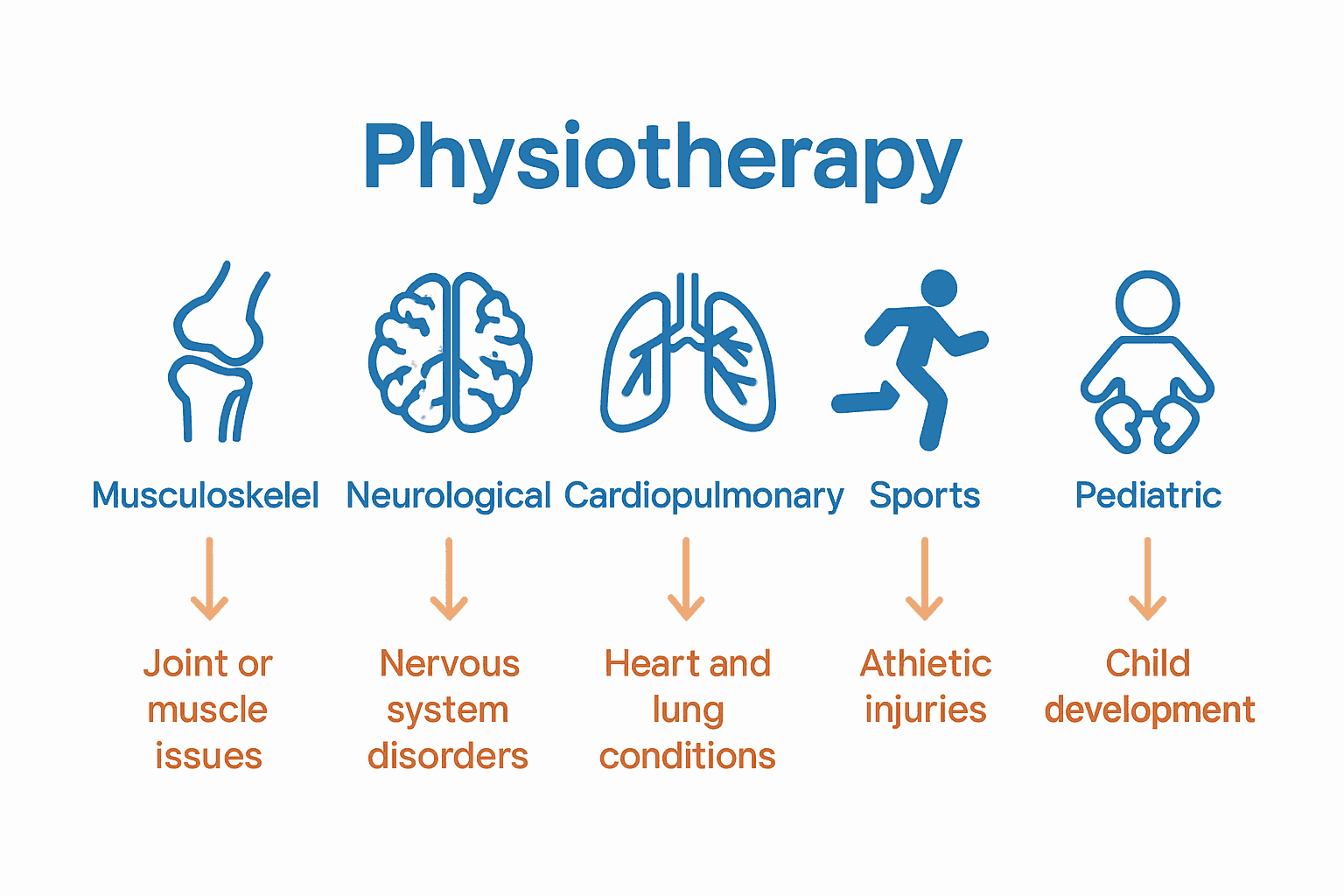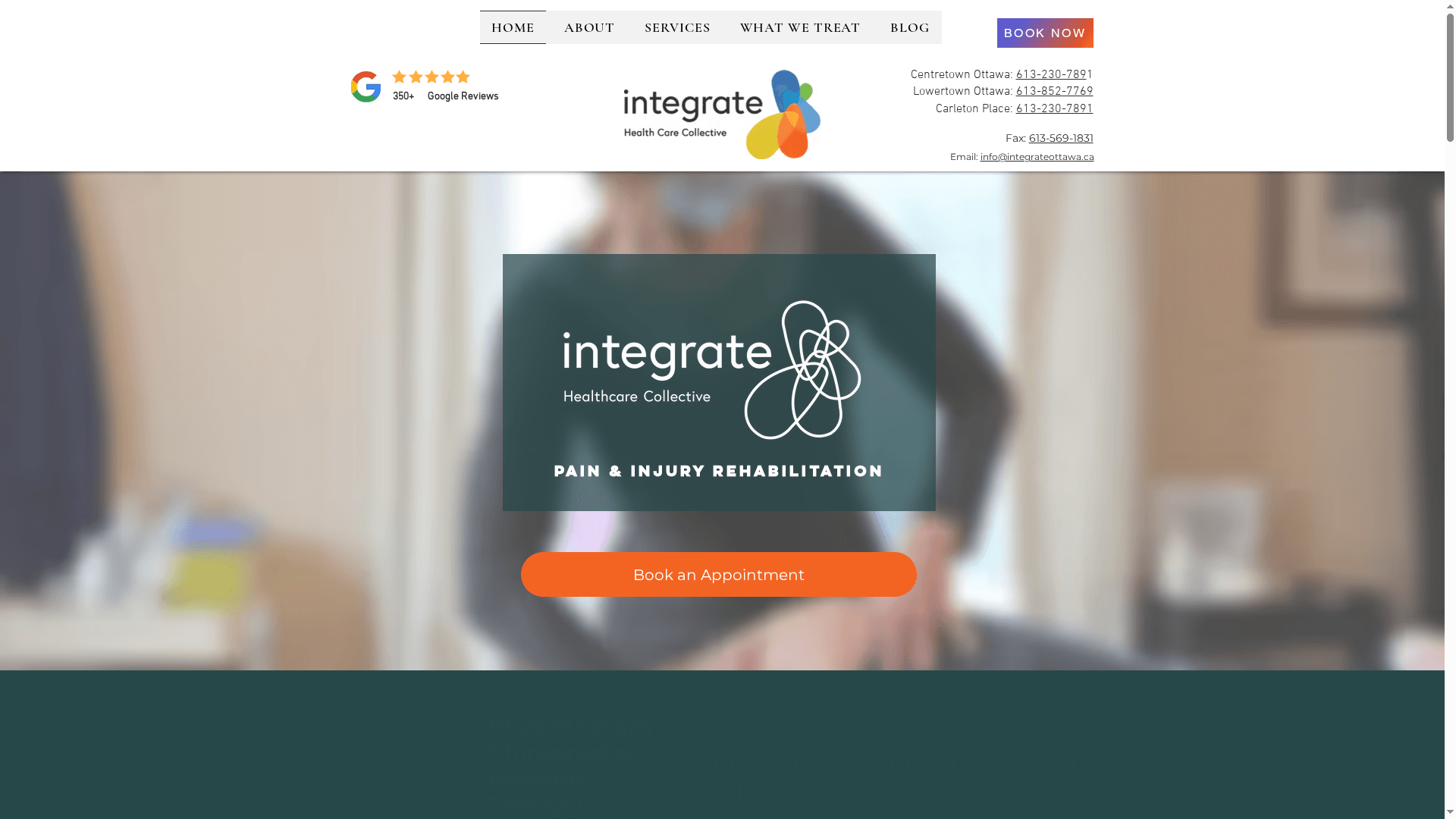Role of Physiotherapy in Recovery: Complete Guide
- Nov 11
- 7 min read

More than one in four adults will need physiotherapy at some point in their lives. Whether recovering from injury, managing chronic pain, or striving for better mobility, many people find that physical challenges can quickly impact every part of daily living. Understanding what physiotherapy truly is—along with its guiding principles and treatment options—means you can make choices that support lasting recovery and better health outcomes.
Table of Contents
Key Takeaways
Point | Details |
Holistic Approach | Physiotherapy emphasizes addressing root causes of physical challenges through personalized treatment plans that encompass physical, mental, and emotional health. |
Types of Treatment | Key physiotherapy types include musculoskeletal, neurological, cardiopulmonary, sports, and pediatric physiotherapy, each targeting specific conditions and recovery goals. |
Patient Engagement | Successful recovery hinges on active patient participation, including adherence to treatment plans, communication with therapists, and lifestyle modifications. |
Collaborative Care | Physiotherapy fosters interdisciplinary collaboration with other healthcare professionals to provide comprehensive care and optimize patient recovery outcomes. |
Defining Physiotherapy and Its Core Principles
Physiotherapy is a comprehensive healthcare profession dedicated to helping individuals restore, maintain, and optimize physical function, movement, and overall wellbeing. At its core, physiotherapy represents a holistic approach to healing that goes beyond treating symptoms, focusing instead on addressing the root causes of physical challenges and supporting patients’ entire rehabilitative journey.
The fundamental principles of physiotherapy revolve around understanding human movement, biomechanics, and the intricate relationships between different body systems. Physiotherapists are trained healthcare professionals who use evidence-based techniques to assess, diagnose, and treat a wide range of musculoskeletal, neurological, and cardiovascular conditions. Their approach is characterized by personalized treatment plans that consider each patient’s unique physical condition, lifestyle, and recovery goals.
Key core principles of physiotherapy include:
Patient-Centered Care: Designing treatment strategies tailored to individual needs
Movement Optimization: Improving physical function and reducing pain through targeted interventions
Preventative Approach: Not just treating existing conditions but preventing future injuries
Holistic Healing: Addressing physical challenges by considering mental, emotional, and physical aspects of health
Physiotherapists employ a diverse range of techniques to support patient recovery, including manual therapy, exercise prescription, electrotherapy, and patient education. For those interested in understanding more about the comprehensive role of physiotherapists, learn more in our complete guide to the role of physiotherapists. This approach ensures that patients receive comprehensive, compassionate care that supports their journey towards optimal physical health and functionality.
Common Types of Physiotherapy Treatments
Physiotherapy encompasses a diverse range of specialized treatment approaches designed to address various physical health conditions and support patient recovery. Each type of physiotherapy focuses on specific body systems and movement challenges, allowing healthcare professionals to provide targeted interventions that promote healing, restore function, and improve overall quality of life.
Musculoskeletal Physiotherapy represents one of the most common treatment types, addressing issues related to muscles, joints, bones, and soft tissues. This approach typically involves techniques such as manual therapy, joint mobilization, targeted exercises, and rehabilitation strategies for conditions like sports injuries, back pain, arthritis, and post-surgical recovery. Patients experiencing chronic pain, limited mobility, or recovering from orthopedic procedures often benefit significantly from these specialized interventions.
Key types of physiotherapy treatments include:
Orthopedic Physiotherapy: Treating muscle, bone, and joint-related conditions
Neurological Physiotherapy: Supporting patients with nerve and brain-related movement disorders
Cardiopulmonary Physiotherapy: Improving respiratory and cardiovascular function
Sports Physiotherapy: Specialized care for athletic injuries and performance enhancement
Pediatric Physiotherapy: Addressing developmental and movement challenges in children
For those interested in understanding the comprehensive benefits of physiotherapy, discover how physiotherapy supports pain relief and recovery. Each treatment type is meticulously designed to support patients’ unique physical needs, ensuring a personalized approach to rehabilitation and wellness.


How Physiotherapy Aids Recovery Processes
Physiotherapy plays a critical role in supporting and accelerating recovery across various medical conditions, offering a comprehensive approach that goes far beyond traditional treatment methods. By addressing the root causes of physical limitations and developing personalized rehabilitation strategies, physiotherapists help patients restore function, reduce pain, and regain their optimal level of mobility and independence.
The recovery process through physiotherapy involves a multifaceted approach that targets healing at multiple levels. Tissue Healing and Rehabilitation form the cornerstone of physiotherapeutic interventions, where professionals use specialized techniques to promote cellular repair, reduce inflammation, and restore biomechanical balance. This includes manual therapy techniques, targeted exercise prescriptions, and advanced modalities like electrical stimulation or ultrasound that actively support the body’s natural healing mechanisms.
Key mechanisms of physiotherapy in recovery include:
Pain Management: Reducing discomfort through manual techniques and strategic interventions
Mobility Restoration: Gradually rebuilding strength, flexibility, and range of motion
Compensatory Strategy Development: Teaching alternative movement patterns to prevent further injury
Psychological Support: Providing motivation and strategies for mental resilience during recovery
Preventative Education: Equipping patients with knowledge to minimize future injury risks
For those seeking deeper insights into why professional physiotherapy can be transformative, learn why seeing a physiotherapist could be crucial for your recovery. Each recovery journey is unique, and physiotherapy offers a personalized roadmap to help patients navigate their rehabilitation with confidence and comprehensive support.
Collaborative Care: Physiotherapy and Other Disciplines
Collaborative healthcare represents a sophisticated approach to patient treatment, where multiple disciplines work together to provide comprehensive, holistic care. Physiotherapy plays a pivotal role in this integrated model, serving as a critical link between different healthcare specialties and ensuring patients receive multidimensional support for their recovery and wellness journey.
According to research from PubMed, effective collaboration requires physiotherapists to develop advanced business and practice management competencies that enable seamless communication and coordination across various healthcare sectors. This interdisciplinary approach allows for a more nuanced understanding of patient needs, combining insights from different medical perspectives to create more comprehensive and targeted treatment strategies.
Key collaborative relationships in physiotherapy include:
Chiropractic Care: Complementary approaches to musculoskeletal health
Medical Physicians: Coordinating treatment plans and diagnostic insights
Massage Therapists: Integrating soft tissue management and rehabilitation
Orthopedic Specialists: Developing comprehensive injury and recovery protocols
Mental Health Professionals: Supporting psychological aspects of physical recovery
Discover how our physiotherapists collaborate with other healthcare professionals to provide comprehensive, patient-centered care. By breaking down traditional medical silos, collaborative care ensures that patients receive holistic, integrated treatment that addresses their physical, mental, and emotional well-being.
Patient Responsibilities and Recovery Expectations
Successful physiotherapy recovery is a collaborative journey that requires active participation and commitment from patients. While physiotherapists provide expert guidance and treatment, the ultimate success of rehabilitation depends significantly on the patient’s willingness to engage fully in their recovery process, follow prescribed protocols, and maintain a proactive approach to healing.
Patient engagement is the cornerstone of effective rehabilitation. This involves more than simply attending scheduled therapy sessions; it requires a comprehensive commitment to following treatment plans, completing home exercise programs, maintaining open communication with healthcare providers, and making necessary lifestyle modifications to support recovery. Patients must understand that their role is not passive but active, with personal commitment playing a crucial part in achieving optimal rehabilitation outcomes.
Key patient responsibilities during physiotherapy recovery include:
Consistent Attendance: Attending all scheduled therapy sessions and being punctual
Home Exercise Compliance: Performing prescribed exercises exactly as instructed
Honest Communication: Providing accurate information about pain levels, progress, and challenges
Lifestyle Modifications: Making recommended changes to support healing
Patience and Realistic Expectations: Understanding that recovery is a gradual process
Explore our comprehensive guide to understanding physiotherapy expectations to help you prepare for a successful rehabilitation journey. Remember, your active participation transforms professional guidance into meaningful, lasting recovery.
Risks, Costs, and Alternative Treatment Options
Navigating the landscape of physiotherapy treatment requires careful consideration of potential risks, financial implications, and available alternative approaches. Patients should approach their rehabilitation journey with a comprehensive understanding of the potential challenges and opportunities associated with physiotherapeutic interventions.
According to the Alliance of Physiotherapists, healthcare professionals are ethically obligated to provide transparent information about treatment risks, potential outcomes, and alternative options. Treatment Risks can vary depending on individual health conditions, ranging from mild discomfort during therapy to rare instances of temporary increased pain or muscle soreness. While these risks are generally minimal, open communication with your physiotherapist is crucial for understanding and mitigating potential complications.
Key considerations for patients include:
Financial Planning: Understanding treatment costs and insurance coverage
Risk Assessment: Discussing potential side effects and complications
Alternative Treatments: Exploring complementary approaches like:
Chiropractic care
Massage therapy
Acupuncture
Occupational therapy
Cost-Effectiveness: Comparing long-term benefits versus immediate expenses
Individual Variability: Recognizing that treatment outcomes differ for each patient
Learn more about why seeing a physiotherapist can be a comprehensive healthcare solution, helping you make an informed decision about your rehabilitation journey. Ultimately, understanding the full spectrum of risks, costs, and options empowers patients to make confident, well-informed healthcare choices.
Take Control of Your Recovery with Expert Physiotherapy Care
If you are facing challenges with pain, limited mobility, or prolonged recovery from injury understanding the role of physiotherapy in recovery can be your first step toward healing. The article highlights the importance of personalized treatment plans, movement optimization, and collaborative care to help you regain strength and prevent future issues. These goals are at the heart of what we offer at Integrate Health Clinic.

Experience a team-based, evidence-supported approach that combines physiotherapy, chiropractic care, and massage therapy to ensure your recovery journey is both comprehensive and compassionate. Do not wait for pain or mobility challenges to hold you back any longer. Visit Integrate Ottawa today to book an appointment and start your tailored rehabilitation plan. Learn more about how physiotherapy supports pain relief and recovery and why working with professional physiotherapists can make all the difference in your healing process.
Frequently Asked Questions
What is the role of physiotherapy in recovery?
Physiotherapy plays a critical role in recovery by providing personalized treatment plans aimed at restoring physical function, reducing pain, and improving overall mobility through evidence-based techniques.
What types of conditions can physiotherapy help with?
Physiotherapy can help with various conditions, including musculoskeletal issues, neurological disorders, cardiovascular problems, sports injuries, and pediatric developmental challenges.
How does physiotherapy aid in pain management?
Physiotherapy aids in pain management through manual therapy techniques, targeted exercises, and education on compensatory strategies to reduce discomfort and improve movement.
What are the key responsibilities of patients during physiotherapy?
Patients are responsible for attending therapy sessions, following prescribed exercise routines, communicating openly with their physiotherapist, making recommended lifestyle changes, and having realistic expectations about their recovery process.
Recommended

Comments